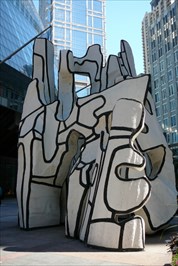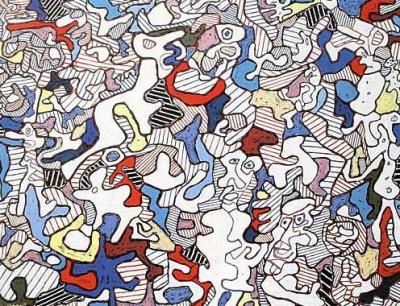
Radieux meteore, 1952
In 1952 Dubuffet returned to Paris and continued the Sols Et Terrains and Lieux Momentanes. In 1953 Dubuffet drew the Terres Radieuses and the Pates Battues series and also stayed in Chaillol with Pierre Bettencourt. Dubuffet also works on lithography with Mourlot in1953. In 1954 Dubuffet attended and participated in a retrospective organised by René Drouin in the Cercle Volney, Paris. Dubuffet also completes the Petites Statues De La Vie Precaire and travels between Paris and Auvergne where Lili (his wife) stays for health reasons. By the end of 1954 Dubuffet also completes the Vaches series. In 1955 Dubuffet moves to Vence where he builds a large studio and a villa. He also completes Assemblages D'empreintes and Tableaux D'assemblage series. Dubuffet also has his
first exhibition in London (Institute of Contemporary Arts) in 1955. (http://www.dubuffetfondation.com/bio_set_ang.htm)
first exhibition in London (Institute of Contemporary Arts) in 1955. (http://www.dubuffetfondation.com/bio_set_ang.htm)






 Jean Dubuffet was a French painter and sculptor who was born in Le Havre, France on July 31, 1901. His idealistic approach to aesthetics embraced so called "low art" and eschewed traditional standards of beauty in favor of what he believed to be a more authentic and humanistic approach to image-making (
Jean Dubuffet was a French painter and sculptor who was born in Le Havre, France on July 31, 1901. His idealistic approach to aesthetics embraced so called "low art" and eschewed traditional standards of beauty in favor of what he believed to be a more authentic and humanistic approach to image-making (